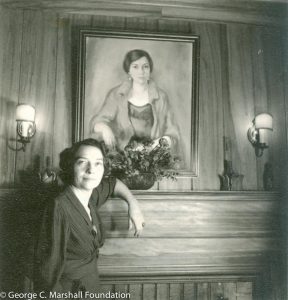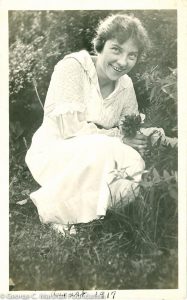I visited the Marshall library for the first time in January 2015, looking for information about the codebreaking poet Elizebeth Smith Friedman. I had been reading about the history of the NSA and its godfather, William Friedman, and in reading about William, I noticed that his wife was also a codebreaker. Two codebreakers, married to each other!
I wanted to know more, particularly about Elizebeth, and when I saw that the Friedmans’ papers were held at the Marshall, I drove there one day, five hours from my home in Philadelphia, and asked to see Elizebeth’s collection. I’ll never forget that moment. The chief archivist, Jeffrey Kozak, unlocked a solid gray metal door and led me into a darkened, humidity-controlled vault. He pointed to multiple shelves of gray boxes, twenty-two boxes in all: the Elizebeth Smith Friedman Collection. He pulled Box 1 from the shelf, carried it out to the reading room, had me sign a slip, and told me to enjoy.The box was crammed with manila folders containing letters from different years of Elizebeth’s life, some handwritten and some typed. I picked up the first folder and started reading. Right away, Elizebeth’s voice leapt off the page. She was so funny and witty and sometimes bitingly sarcastic. And I realized pretty quickly that I was looking at pieces of an incredible and untold American story.

This was a woman who did big groundbreaking things. She helped invent the modern science of codebreaking that lays at the foundation of our intelligence agencies today. She was an early master of radio intelligence and counter-espionage, using her abilities to map various criminal underworlds and shine a light on dark place. And all the time she was the inspiration and life partner of William Friedman, one half of a husband-and-wife codebreaking duo that changed the shape of the 20th century.
I was surprised by the texture and richness of Elizebeth’s materials. Codebreaking is such a secret profession, but she seemed to have kept every scrap of paper that wasn’t classified. Elizebeth left behind thousands of documents about her fight against smugglers and gangsters during the 1920s and 1930s, including her original code worksheets written in pencil. She left her earliest love letters to William during World War I, some of which were written in snippets of code and cipher. It’s just a great wealth of precious stuff. Ultimately I spent two weeks going through Elizebeth’s entire collection, start to finish, and by the time I finished with Box 22, I thought, holy hell, I have to try to tell this tale, to do justice to what’s here. I knew it was a story about America’s first great woman codebreaker, a pioneer who was famous in her day but is now forgotten. But because Elizebeth was so crucial to the history and evolution of multiple U.S. intelligence agencies, it was also a story about the birth and growth of American intelligence itself.
I also suspected that there might be more to the story. There was a gap in the boxes where World  War II was supposed to be. The Marshall archivists had done such a wonderful job caring for her files that this gap stood out to me. It screamed, “There’s a mystery here.” So I went hunting for the missing files. It took me two years to find them. They’re in the National Archives in College Park, Maryland. The documents are stamped TOP SECRET ULTRA. They were classified for decades after the war. They reveal that Elizebeth spent the war hunting Nazi spies. She intercepted their radio messages, broke the codes, and provided the decrypts to Allied intelligence agencies, ultimately destroying the spy rings and eliminating a threat to America. After I found Elizebeth’s war records, I was able to return to the Marshall library and look at her materials with a new set of eyes. A few cryptic references to “the spy stuff” and “counter-spying” finally made sense.
War II was supposed to be. The Marshall archivists had done such a wonderful job caring for her files that this gap stood out to me. It screamed, “There’s a mystery here.” So I went hunting for the missing files. It took me two years to find them. They’re in the National Archives in College Park, Maryland. The documents are stamped TOP SECRET ULTRA. They were classified for decades after the war. They reveal that Elizebeth spent the war hunting Nazi spies. She intercepted their radio messages, broke the codes, and provided the decrypts to Allied intelligence agencies, ultimately destroying the spy rings and eliminating a threat to America. After I found Elizebeth’s war records, I was able to return to the Marshall library and look at her materials with a new set of eyes. A few cryptic references to “the spy stuff” and “counter-spying” finally made sense.
Elizebeth wanted to tell her own story. All through her life she wrote autobiographical letters and bits of book chapters that were never published. For instance, in the late 1950s, she wrote the foreword to a memoir of her war years—only the foreword. Secrecy rules prevented her from going further. But she left behind all the pieces of the tale, for future researchers to sift through and arrange, and that’s what I have tried to do with my book about Elizebeth, THE WOMAN WHO SMASHED CODES. I hope the book goes some way toward restoring Elizebeth to her rightful place in history, as a puzzle-solving heroine of the world wars and one of the greatest codebreakers who ever lived.
Jason Fagone is a reporter and author who covers science, technology, and culture. He works as an investigative reporter at the San Francisco Chronicle, the largest newspaper in Northern California. Jason lives in San Francisco with his wife, daughter and dog.
Jason has written three nonfiction books. His first, Horseman of the Esophagus (2005), explored the world of competitive eating and the American appetite. He followed that with Ingenious (2012), the story of a $10 million prize to build the super-efficient car of the future.
In 2013, Jason began researching the life of codebreaker Elizebeth Smith Friedman and found his way to the Marshall Foundation, diving into the library’s remarkable collection of Elizebeth’s letters. The result is his book The Woman Who Smashed Codes, published last year by Dey Street/Harper Collins. It was named one of NPR’s Best Books of 2017 and a 2018 Notable Book of the American Library Association. The book is now being developed into a TV series by the creators of the show “The Good Wife.”
If you like reading our blogs, please support us by becoming a member of the Foundation

